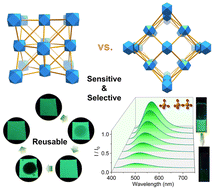Topological control of metal–organic frameworks toward highly sensitive and selective detection of chromate and dichromate†
Abstract
Luminescent metal–organic frameworks (LMOFs) have been extensively used as sensitive and selective sensors for carcinogenic chromium(VI) oxyanions. However, the correlation between the MOF structure and the Cr(VI) sensing efficacy remains underexplored, hindering the rational design of MOFs for Cr(VI) sensing. Herein, we overcome this challenge by judiciously selecting the rarely touched thorium cations and a tetraphenylethene-based ligand for building two novel thorium-based MOFs, Th-BCTPE-1 and Th-BCTPE-2. Despite being built from identical precursors, Th-BCTPE-1 shows more sensitive luminescence quenching responses to CrO42− and Cr2O72− than Th-BCTPE-2, producing the second highest quenching constants of CrO42− among all LMOF-based Cr(VI) sensors. We further decoupled the influences of different structural variables and the corresponding physiochemical properties, including porosity, BET surface area, photoluminescence quantum yield, and adsorption capacity, showing that the sensing efficacy of Cr(VI) oxyanions is more relevant to the adsorption capacity and the degree of the inner filter effect than the rest of the variables in this system.

- This article is part of the themed collections: Inorganic Chemistry Frontiers Emerging Investigator Series 2022–2023 and FOCUS: Design and applications of metal-organic frameworks (MOFs)


 Please wait while we load your content...
Please wait while we load your content...